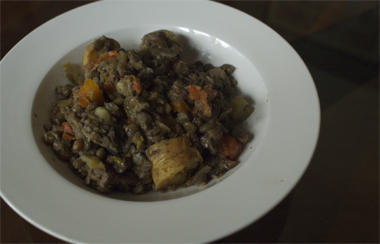Everything I know about food in the context of a stodgy looking plate of lamb and green lentils
Technically it's a braise and that's often the cooking method of choice for cheaper and tougher cuts but that doesn't exclude other cuts. The temperature is lower than an oven but the heat conductivity of the water, which surrounds the meat, is much more efficient. The connective tissue and collagen is broken down with cooking time is transformed into gelatin. Gelatin will thicken the sauce and give it mouthfeel. Bones are also good. So for this reason I grabbed some lamb chops out of the freezer and complimented them with shanks.
Dust the meat with flour and brown them quickly after or the flour goes soggy with juices. Much is said about sealing the meat but the browning adds flavour to the meat by a process known as the Maillard reaction which is a chemical reaction that occurs with amino acids and heat (like sugars and caramelisation) . I'm not entirely sure if the same happens with the flour the meat is dusted with but the flavours will disperse with the flour and the flour acts as a thickener. I've also heard that with fish, a dusting of flour will 'dry' the exterior so the fish sears in contact with the pan rather than steams. Remove and drain off any excess fat, much of the flavour is still stuck to the pan and this can be deglazed with a little stock and some scraping.
The similarity with a stock means that there's a flavour base of aromatics - garlic, onion, celery and carrots. This is referred to in French as a mirepoix. The mirepoix was softened gently or 'sweated' in olive oil until soft. The size of the mirepoix depends on the length of cooking. A brief half hour fish stock will need small cubes but a longer cooking process can allow larger pieces which add to the biteable elements in the dish - celery and onion not so much but carrots yes.
The flavour gets a boost from adding half a litre of chicken stock and then topped up with water. You could do without it but a watery taste is to no-one's liking and ther should be something for the lentils to soak up. The other flavour comes from a traditional bouquet garni combo of thyme, bay leaf and parsley. Personally I find popping out to the herb garden a wee bit special.
Added to the mix are kipfler potatoes, which keep their shape well. Potatoes are often mixed to stews for their carbohydrates but their starch also acts as a thickener.
Bring to the boil and skim off the scum and place in a 180C oven for an hour or so. The lid will increase the efficiency of cooking by raising the boiling point in a mild facsimile of a pressure cooker. It'll also mean that the cooking liquid doesn't reduce but that's OK because you'll need it for the lentils.
Lentils have long been a source of suspicion for transgression of established barriers on protein and meat (pace tofu). Green lentils, unlike other legumes,don't require soaking before cooking just needing a rinse and then cooking until tender. This can vary but half an hour is good balance between chewy and mush. Add the lentils and continue cooking - if there's excess liquid you can crack the lid open to allow steam to escape and the liquid to reduce.
At the same time, the dish lacks a bit of acidity and this could be wine (didn't have any) or lemon (ditto) so I went with tomatoes. Just some cherry tomatoes pan fried with olive oil and basil until broken down for extra taste and mixed in at the same time as the lentils.













3 Comments:
You left out the "You and your fed ones will be happy" part.
9/13/2007 08:30:00 am
Ooh ta! And I forgot remove and shred the meat.
9/13/2007 10:13:00 am
What amazing recipes and pictures, Generally choose my amazing recipes from Cooking.com and ChefsCatalog.com stores at Couponalbum.com
..
10/12/2007 07:38:00 pm
Post a Comment
<< Home